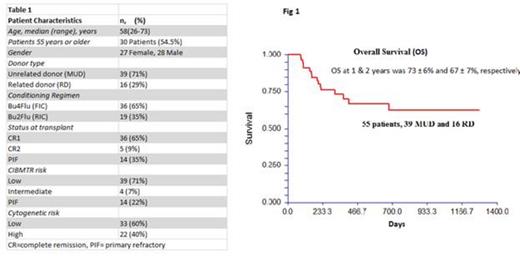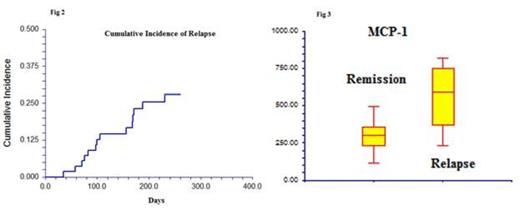Abstract
Reduced and full intensity conditioning (RIC, FIC) regimens employing intravenous (i.v.) busulfan plus fludarabine (Bu-Flu) have resulted in improved treatment related mortality and comparable overall survival in patients undergoing allogeneic HCT for AML/MDS who are not candidates for more intense regimens. However, relapse after HCT remains a leading cause of treatment failure after such conditioning regimens.
In Order to assess relapse following allogeneic HCT for AML/MDS, a retrospective analysis was performed to evaluate the outcomes of 55 consecutive patients with AML/MDS (49/6) who received i.v. Bu-Flu based conditioning. Blood samples were collected post HCT in a subset of those patients (30 patients). Serum values of 42 biological markers were measured at day 30 post HCT (2/30 patients were day 60 samples) using multiplex Luminex assay. Patients characteristic are shown in Table-1. Patients received single daily dose of iv Bu 3.2 mg/kg for 2 days (RIC, Bu2-Flu) or 4 days (FIC, Bu4-Flu) based on age, older or younger than 65 respectively. Fludarabine was given as a single daily dose of 40 mg/Kg for 4 days. Graft versus host disease prophylaxis was Tacrolimus/Methotrexate in FIC recipients and Tacrolimus/Mycophenolate in RIC recipients. Low dose thymoglobulin of 4.5 mg/kg was used in unrelated donor HCT recipients.
With a median follow up of 18 month, the overall survival (OS) at 1 & 2 years was 73 ± 6% and 67 ± 7%, respectively, (Fig 1). Similarly, disease free survival at 1 and 2 years was 64 ± 7%. As expected, there was low cumulative incidence of treatment related mortality of 8 ± 3% at 1 and 2 years while the cumulative incidence of relapse was 28.0 ± 3% and 31± 2% at 1 and 2 years respectively, (Fig 2). Cumulative incidence of grade II-IV acute GVHD was 54% with grade III-IV of 25% at day 100. Cumulative incidence of chronic GVHD was 49, 54% at 1 and 2 years respectively. In a subset of patients where chemokine analysis was performed (30 patients), only MCP-1 levels at day 30 post HCT were predictive of relapse out of the 42 biological markers tested. The 7 out of 30 patients who relapsed in this subset (23%) had higher mean level of MCP-1 at day 30 of 537, SD ±213 versus 324, SD ± 160, P=0.007, (Fig 3). MCP-1 was predictive of leukemic relapse 82 days in advance on average prior to overt hematological relapse. Full chimerism (>95%) was detected at Day 30 in 5/7 patients who relapsed in the biological marker group.
Bu-Flu based conditioning regimens result in improved OS in patients with AML/MDS but do not impact relapse rate after allogeneic HCT. Serum MCP-1 levels in the early post-transplant period were predictive of relapse in subset of patients where post HCT biomarkers were available. Future larger studies may find potential role of MCP-1 in predicting relapse in patients at risk after HCT with Bu-Flu for AML/MDS.
No relevant conflicts of interest to declare.
Author notes
Asterisk with author names denotes non-ASH members.



This feature is available to Subscribers Only
Sign In or Create an Account Close Modal